On June 28, 2024, the first steel cutting ceremony for the experimental hull section was held at the Canadian shipbuilding company Irving Shipbuilding in Halifax, marking the beginning of the construction program for the Canadian Navy of 15 promising River-type destroyers designated as Canadian Surface Combatant (CSS). At the same time, on the same day, the Canadian Ministry of Defense signed a formal contract with Irving Shipbuilding for the construction of the first three CSC ships named Fraser, Saint-Laurent and Mackenzie. The actual construction of the Fraser lead ship will be started by Irving Shipbuilding in 2025, with the planned transfer of the ship for testing in the early 2030s and a deadline for delivery to the Canadian Navy by 2035.
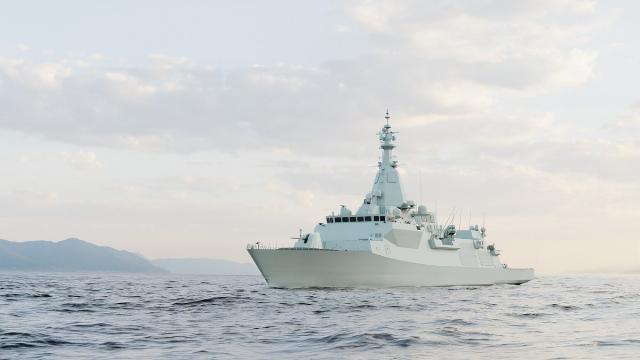
An image of a promising Canadian River-type destroyer (c) of the Canadian Navy
At the ceremony, it was announced that the Canadian Navy decided to classify the CSC ships as missile and helicopter armed destroyers (DDGH) and assign the designation Type River to the entire type. Accordingly, all 15 ships of this type planned for construction will receive traditional names for Canadian Navy ships in honor of Canadian rivers.
Promising Canadian River-type destroyers are a modified version of the project of the new British Type 26 frigates. Recall that in October 2018, the Government of Canada, together with Irving Shipbuilding, selected the Canada's Combat Ship Team consortium headed by the Canadian branch of Lockheed Martin Corporation (Lockheed Martin Canada Inc.) as the preferred supplier in the tender for construction for the Royal Canadian Navy 15 promising frigates (then) under the Canadian Surface Combatant (CSS) program. Led by Lockheed Martin Canada Inc., Canada's Combat Ship Team consortium has proposed a frigate project based on the new British Type 26 frigate. The Combat Ship Team consortium also includes BAE Systems Corporations (developer of the Type 26 Global Combat Ship frigate project), CAE, MDA, L3 Harris and Ultra Electronics. Irving Shipbuilding was identified from the very beginning as the lead contractor for the construction of ships. In February 2019, the Canada's Combat Ship Team consortium received a contract for the full-fledged technical design of the CSC ship for the Canadian Navy based on the Type 26 frigate project.
Launched back in 2008, the Canadian Surface Combatant program (CSC: originally called the Single Class Surface Combatant Project) provides for the construction of 15 new large surface ships of a single type for the Canadian Navy to replace three Iroquois-type destroyers (the last of which was decommissioned in 2017) and 12 Halifax-type frigates in service.
The CSC program has undergone numerous delays and cost increases. The commissioning of the lead ship of the new type is now scheduled for 2035, that is, a decade later than the original plans. It is now expected that the Canadian Navy will commission the first nine River-class ships by 2040, and six more by 2050. The total cost of the entire program for the design and construction of 15 ships, as well as the purchase of equipment and weapons for them, is now officially estimated at 56-60 billion Canadian dollars (41-44 billion US dollars), but back in 2021, the budget control office of the Canadian Parliament estimated the possible actual cost of the program from 77 to 82 billion Canadian dollars (56-60 billion US dollars).
Promising Canadian River-type destroyers will be large ships with a standard displacement of 8080 tons, a length of 151.4 m and a width of 20.75 m. The ships as a whole will retain the hull and the combined diesel-gas turbine-electric (CODLOG) main power plant of the Type 26 frigate, but will receive fundamentally new electronic weapons, the main of which will be the American AEGIS integrated weapon system with the new Lockheed Martin Canada AN/SPY-7(V)3 radar system with extensive capabilities and additional radars missile guidance systems developed by the Canadian company MDA. The ships will receive a Canadian-designed CMS 330 ACB. The supplier of communication and data transmission systems, automation tools, navigation radars, and electron-optical systems will be L3 Harris Corporation, and the supplier of sonar systems (towed GAS TFLAS, podkilnaya GAS S2150, towed anti-torpedo system Sea Sentor S21700) will be Ultra Electronics. The ships will be equipped with the Raytheon AN/SLQ-32(V)6 electronic warfare system and the BAE Systems Mk 53 Nulka anti-torpedo protection system.
The armament of the River-type ships will consist of eight Kongsberg NSM anti-ship missile launchers, a 24-charge Mk 41 universal vertical launcher with ESSM Block II anti-aircraft guided missiles (four per cell) and Standard SM-2 and Tomahawk cruise missiles, two 21-charge MK 49 RAM Block 2 self-defense missile launchers, one 127 mm/64 Leonardo OTO LW universal artillery system with Vulcano guided weapons system, two 30 mm remotely operated Leonardo Lionfish artillery units, four 324 mm torpedo tubes for Mk 54 anti-submarine torpedoes. The ship will carry one CH-148 Cyclone helicopter (Sikorsky S-92) in the hangar and will be adapted to carry UAVs. In the aft part of the ship there will be a compartment for carrying fast-launching boats and placing containerized loads.

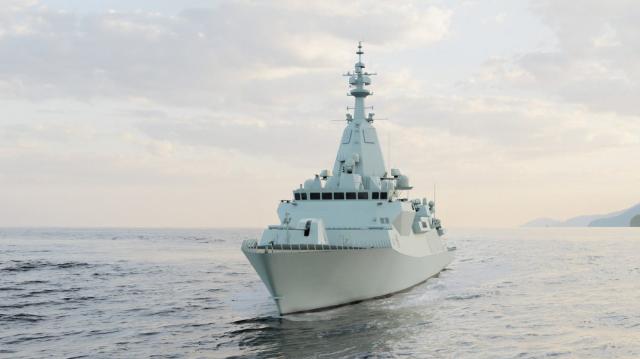
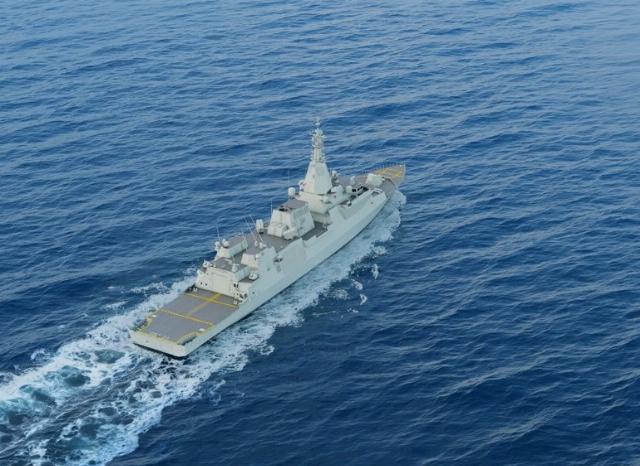
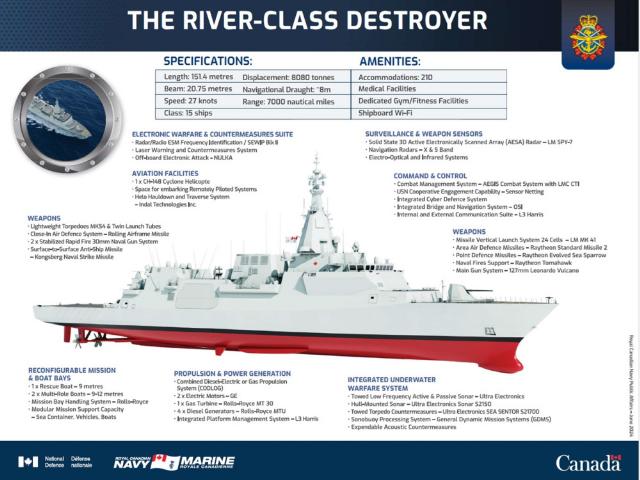
An image of a promising Canadian River-type destroyer (c) of the Canadian Navy
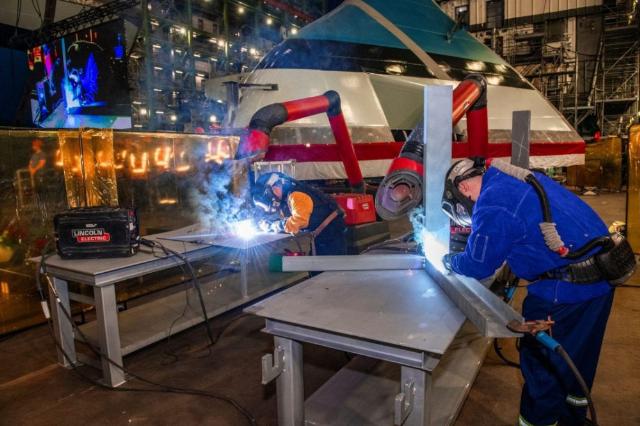
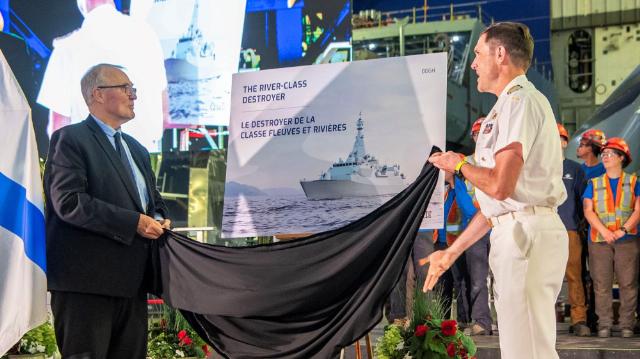
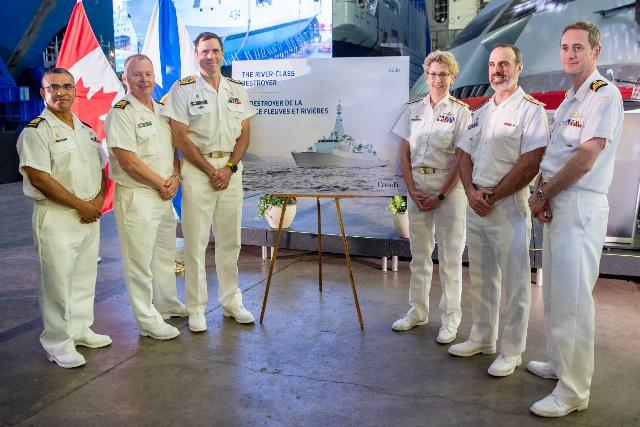
The ceremony of the first steel cutting for the experimental hull section at the Canadian shipbuilding company Irving Shipbuilding in Halifax, which marked the beginning of the construction program for the Canadian Navy of 15 promising River-type destroyers, 06/28/2024 (c) Irving Shipbuilding and the Canadian Navy
Video:
